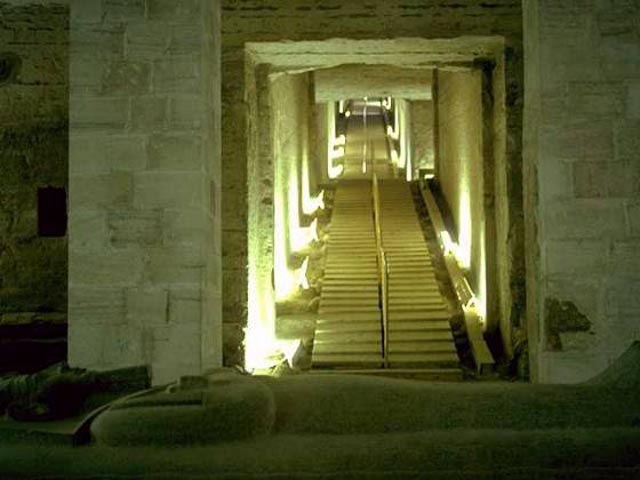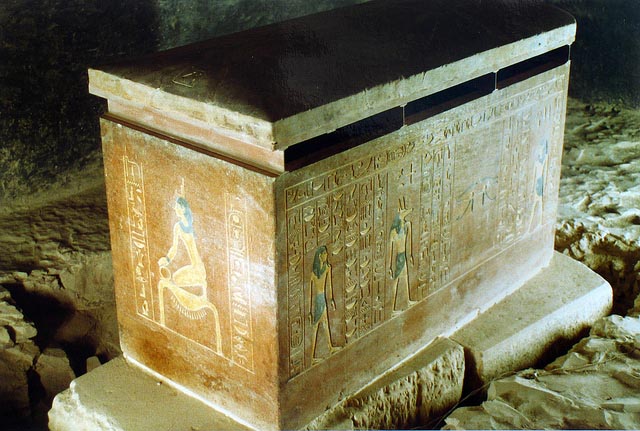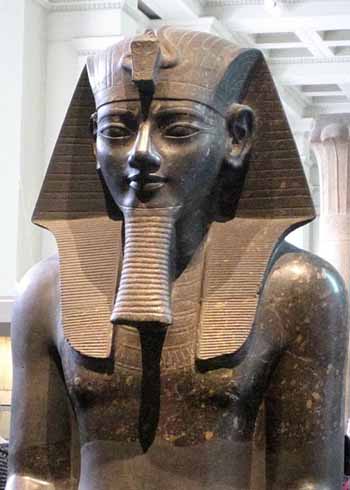

Amenhotep III (sometimes read as Amenophis III; Egyptian Amana-Hatpa The son of the future Thutmose IV (the son of Amenhotep II) and a minor wife Mutemwiya, Amenhotep was born around 1388 BC. He was a member of the Thutmosid family that had ruled Egypt for almost 150 years since the reign of Thutmose I.
Amenhotep III was the father of two sons with his Great Royal Wife Tiye, a queen who could be considered as the progenitor of monotheism through her first son, Crown Prince Thutmose, who predeceased his father, and her second son, Amenhotep IV, later known as Akhenaten, who ultimately succeeded Amenhotep III to the throne. Amenhotep III also may have been the father of a third child - called Smenkhkare, who later would succeed Akhenaten, briefly rule Egypt as pharaoh, and who is thought to have been a woman.
Amenhotep III and Tiye may also have had four daughters: Sitamun, Henuttaneb, Isis or Iset, and Nebetah. They appear frequently on statues and reliefs during the reign of their father and also are represented by smaller objects - with the exception of Nebetah. Nebetah is attested only once in the known historical records on a colossal limestone group of statues from Medinet Habu.
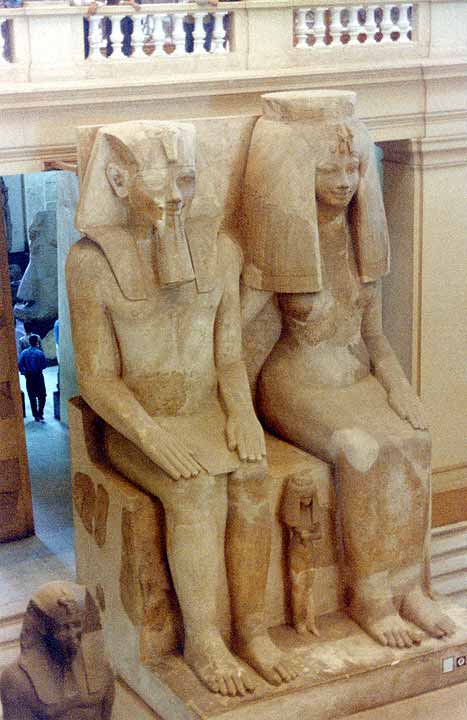
Monumental statue of Amenhotep III and Queen Tiy, along with their daughters
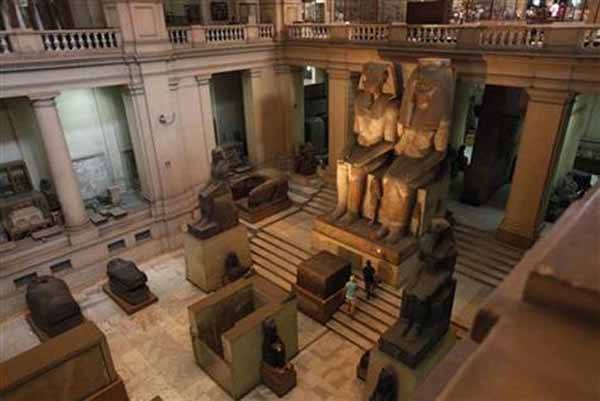

Scientists recreate the face of Tutankhamun's grandfather, Amenhotep III, for the first time in 3,400 years Daily Mail - May 20, 2024
He ruled ancient Egypt at the height of its powers, was worshipped as a living god, and was the grandfather of Tutankhamun. Now the true face of Amenhotep III has been revealed using the skull of his mummy.
The son of the future Thutmose IV (the son of Amenhotep II) and a minor wife Mutemwiya, Amenhotep was born around 1388 BC. He was a member of the Thutmosid family that had ruled Egypt for almost 150 years since the reign of Thutmose I.
Amenhotep III was the father of two sons with his Great Royal Wife Tiye, a queen who could be considered as the progenitor of monotheism through her first son, Crown Prince Thutmose, who predeceased his father, and her second son, Amenhotep IV, later known as Akhenaten, who ultimately succeeded Amenhotep III to the throne. Amenhotep III also may have been the father of a third child - called Smenkhkare, who later would succeed Akhenaten, briefly rule Egypt as pharaoh, and who is thought to have been a woman.
Amenhotep III and Tiye may also have had four daughters: Sitamun, Henuttaneb, Isis or Iset, and Nebetah. They appear frequently on statues and reliefs during the reign of their father and also are represented by smaller objects - with the exception of Nebetah. Nebetah is attested only once in the known historical records on a colossal limestone group of statues from Medinet Habu This huge sculpture, that is seven meters high, shows Amenhotep III and Tiye seated side by side, "with three of their daughters standing in front of the throne - Henuttaneb, the largest and best preserved, in the centre; Nebetah on the right; and another, whose name is destroyed, on the left."
Amenhotep III elevated two of his four daughters - Sitamun and Isis - to the office of "great royal wife" during the last decade of his reign. Evidence that Sitamun already was promoted to this office by Year 30 of his reign, is known from jar-label inscriptions uncovered from the royal palace at Malkata. It should be noted that Egypt's theological paradigm encouraged a male pharaoh to accept royal women from several different generations as wives to strengthen the chances of his offspring succeeding him. The goddess Hathor herself was related to Ra as first the mother and later wife and daughter of the god when he rose to prominence in the pantheon of the Ancient Egyptian religion. Hence, Amenhotep III's marriage to his two daughters should not be considered unlikely based on contemporary views of marriage.
Amenhotep III is known to have married several foreign women:
Tadukhepa, the daughter of his ally Tushratta of Mitanni, Around Year 36 of his reign.
A daughter of Kurigalzu, king of Babylon.
A daughter of Kadashman-Enlil, king of Babylon.
A daughter of Tarhundaradu, ruler of Arzawa.
A daughter of the ruler of Ammia (in modern Syria)
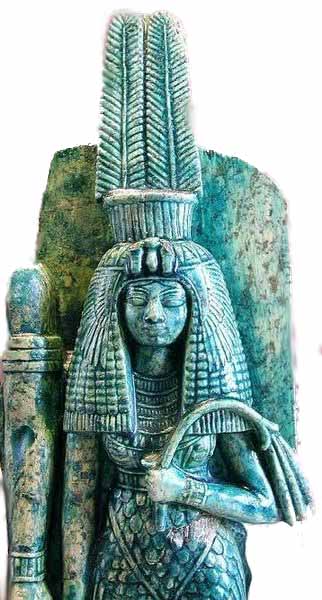
Queen Tiye
Eleven scarabs record the excavation of an artificial lake he had
built for his royal wife, Queen Tiye, in his eleventh regnal year.
Amenhotep III enjoyed the distinction of having the most surviving statues of any Egyptian pharaoh, with over 250 of his statues having been discovered and identified. Since these statues span his entire life, they provide a series of portraits covering the entire length of his reign.
Another striking characteristic of Amenhotep III's reign is the series of over 200 large commemorative stone scarabs that have been discovered over a large geographic area ranging from Syria (Ras Shamra) through to Soleb in Nubia. Their lengthy inscribed texts extol the accomplishments of the pharaoh. For instance, 123 of these commemorative scarabs record the large number of lions (either 102 or 110 depending on the reading) that Amenhotep III killed "with his own arrows" from his first regnal year up to his tenth year. Similarly, five other scarabs state that the foreign princess who would become a wife to him, Gilukhepa, arrived in Egypt with a retinue of 317 women. She was the first of many such princesses who would enter the pharaoh's household.
Amenhotep appears to have been crowned while still a child, perhaps between the ages of 6 and 12. It is likely that a regent acted for him if he was made pharaoh at that early age. He married Tiye two years later and she lived twelve years after his death. His lengthy reign was a period of unprecedented prosperity and artistic splendour, when Egypt reached the peak of her artistic and international power. Proof of this is shown by the diplomatic correspondence from the rulers of Assyria, Mitanni, Babylon, and Hatti which is preserved in the archive of Amarna Letters; these letters document frequent requests by these rulers for gold and numerous other gifts from the pharaoh. The letters cover the period from Year 30 of Amenhotep III until at least the end of Akhenaten's reign. In one famous correspondence - Amarna letter EA 4 - Amenhotep III is quoted by the Babylonian king Kadashman-Enlil I in firmly rejecting the latter's entreaty to marry one of this pharaoh's daughters -- "From time immemorial, no daughter of the king of Egy[pt] is given to anyone."
Amenhotep III's refusal to allow one of his daughters to be married to the Babylonian monarch may indeed be connected with Egyptian traditional royal practices that could provide a claim upon the throne through marriage to a royal princess, or, it be viewed as a shrewd attempt on his part to enhance Egypt's prestige over those of her neighbors in the international world.
The pharaoh's reign was relatively peaceful and uneventful. The only recorded military activity by the king is commemorated by three rock-carved stelas from his fifth year found near Aswan and Sai Island in Nubia. The official account of Amenhotep III's military victory emphasizes his martial prowess with the typical hyperbole used by all pharaohs.
Amenhotep III celebrated three Jubilee Sed festivals, in his Year 30, Year 34, and Year 37 respectively at his Malkata summer palace in Western Thebes. The palace, called Per-Hay or "House of Rejoicing" in ancient times, comprised a temple of Amun and a festival hall built especially for this occasion. One of the king's most popular epithets was Aten-tjehen which means "the Dazzling Sun Disk"; it appears in his titulary at Luxor temple and, more frequently, was used as the name for one of his palaces as well as the Year 11 royal barge, and denotes a company of men in Amenhotep's army.
Amenhotep III built extensively at the temple of Karnak including the Luxor temple which consisted of two pylons, a colonnade behind the new temple entrance, and a new temple to the goddess Ma'at. Amenhotep III dismantled the fourth pylon of the Temple of Amun at Karnak to construct a new pylon - the third pylon - and created a new entrance to this structure where he erected "two rows of columns with open papyrus capitals" down the centre of this newly formed forecourt.
The forecourt between the third and fourth pylons of Egypt, sometimes called an obelisk court, was also decorated with scenes of the sacred barque of the deities Amun, Mut, and Khonsu being carried in funerary boats. The king also started work on the Tenth pylon at the Temple of Amun there. Amenhotep III's first recorded act as king - in his Years 1 and 2 - was to open new limestone quarries at Tura, just south of Cairo and at Dayr al-Barsha in Middle Egypt in order to herald his great building projects. He oversaw construction of another temple to Ma'at at Luxor and virtually covered Nubia with numerous monuments.
His enormous mortuary temple on the west bank of the Nile was, in its day, the largest religious complex in Thebes, but unfortunately, the king chose to build it too close to the floodplain and less than two hundred years later, it stood in ruins. Much of the masonry was purloined by Merneptah and later pharaohs for their own construction projects.
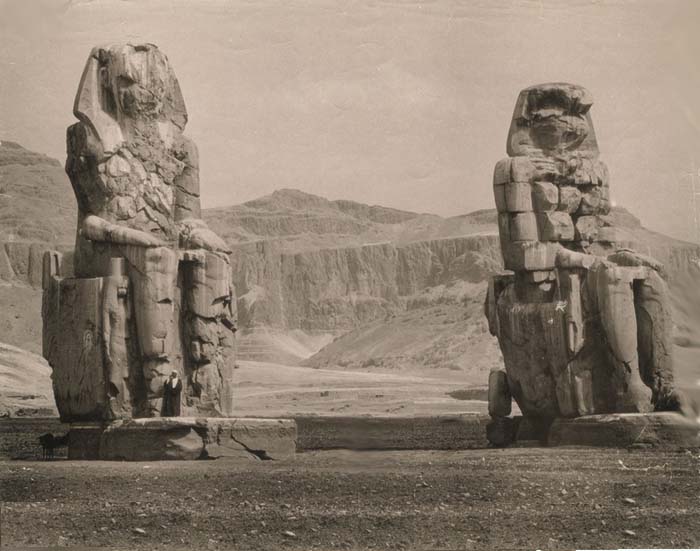
The Colossi of Memnon - two massive stone statues, eighteen meters high, of Amenhotep that stood at the gateway of his mortuary temple - are the only elements of the complex that remained standing. Amenhotep III also built the Third Pylon at Karnak and erected 600 statues of the goddess Sekhmet in the Temple of Mut, south of Karnak. Some of the most magnificent statues of New Kingdom Egypt date to his reign "such as the two outstanding couchant rose granite lions originally set before the temple at Soleb in Nubia" as well as a large series of royal sculptures. Several beautiful black granite seated statues of Amenhotep wearing the nemes headress have come from excavations behind the Colossi of Memnon as well as from Tanis in the Delta.
One of the most stunning finds of royal statues dating to his reign was made as recently as 1989 in the courtyard of Amenhotep III's colonnade of the Temple of Luxor where a cache of statues was found, including a 6 feet (1.8 m)-high pink quartzite statue of the king wearing the Double Crown found in near-perfect condition. It was mounted on a sled, and may have been a cult statue. The only damage it had sustained was that the name of the god Amun had been hacked out wherever it appeared in the pharaoh's cartouche, clearly done as part of the systematic effort to eliminate any mention of this god during the reign of his successor, Akhenaton.

Archaeologists in Egypt have discovered two colossal limestone statues of King Amenhotep III that are fashioned to look like sphinxes Science Alert - January 25, 2022
An Egyptian-German archaeological mission discovered the sphinx-like statues, which were originally about 26 feet (8 meters) long when they were created for King Amenhotep III, an 18th-dynasty king whose reign (about 1390 BCE to 1353 BCE) is known for its peace and prosperity, and whose grandson was King Tutankhamun. The team unearthed the sphinxes in the ancient capital of Thebes (modern-day Luxor) at the mortuary temple of King Amenhotep III, which was called the "Temple of Millions of Years" by ancient Egyptians.
The sphinx-like Amenhotep III depictions are known as colossi, or larger-than-life statues. The archaeological mission - the Colossi of Memnon and Amenhotep III Temple Conservation Project, which started in 1998 - also discovered ruins of columns and walls at the mortuary temple that ancient Egyptians had decorated with ceremonial and ritual scenes, according to Al-Monitor, a news outlet that covers the Middle East. The two colossi show Amenhotep III wearing a mongoose-shaped headdress, a royal beard and a broad necklace, Mustafa Waziri, secretary-general of the Supreme Council of Antiquities, said in the statement. A restoration revealed an inscription across the chest of one of the colossi that read "the beloved of Amun-Re," a reference to Amenhotep III. This temple housed a large number of statues, models and wall decorations, before it was hit by a devastating earthquake in 1200 BC.
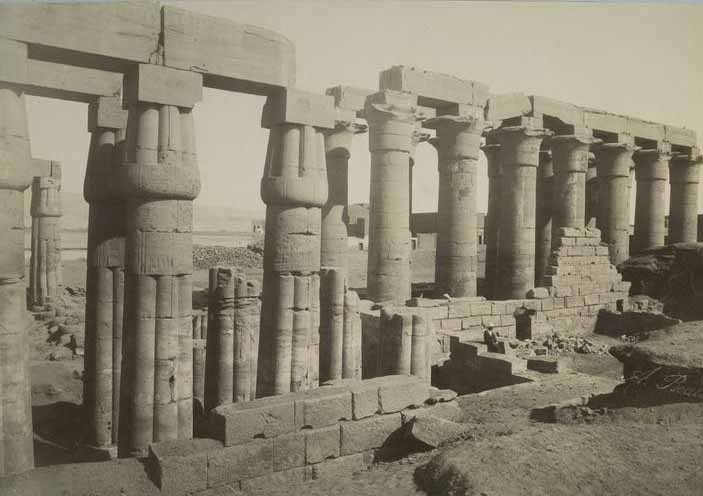
Luxor Temple of Amenhotep III

Amenhotep III and Sobek, from Dahamsha, now in the Luxor Museum
Reliefs from the wall of the temple of Soleb in Nubia and scenes from the Theban tomb of Kheruef, Steward of the King's Great Wife, Tiye, depict Amenhotep as a visibly weak and sick figure. Scientists believe that in his final years he suffered from arthritis and became obese. It has generally been assumed by some scholars that Amenhotep requested and received from his father-in-law Tushratta of Mitanni, a statue of Ishtar of Nineveh--a healing goddess - in order to cure him of his various ailments which included painful abscesses in his teeth.
A forensic examination of his mummy shows that he was probably in constant pain during his final years due to his worn, and cavity-pitted teeth. However, more recent analysis of Amarna letter EA 23 by William L. Moran, which recounts the dispatch of the statue of the goddess to Thebes, does not support this popular theory. The arrival of the statue is known to have coincided with Amenhotep III's marriage with Tadukhepa, Tushratta's daughter, in the pharaoh's 36th year; letter EA 23's arrival in Egypt is dated to "regnal year 36, the fourth month of winter, day 1" of his reign. Furthermore, Tushratta never mentions in EA 23 that the statue's dispatch was meant to heal Amenhotep from his maladies.
Amenhotep III's highest attested reign date comes from a pair of Year 38 wine jar-label dockets from Malkata; though he may have lived briefly into an unrecorded 39th Year and died before the wine harvest for that year arrived.
Amenhotep III was buried in the Western Valley of the Valley of the Kings, in Tomb WV22. Sometime during the Third Intermediate Period his mummy was moved from this tomb and was placed in a side-chamber of KV35 along with several other pharaohs of the Eighteenth and Nineteenth dynasties where it lay until discovered by Victor Loret in 1898.
An examination of his mummy by the Australian anatomist Grafton Elliot Smith concluded that the pharaoh was aged between forty and fifty years old at death. His chief wife, Tiye, is known to have outlived him for at least twelve years as she is mentioned in several Amarna letters dated from her son's reign as well as depicted at a dinner table with Akhenaten and his royal family in scenes from the tomb of Huya, which were made during Year 9 and Year 12 of her son's reign.
When Amenhotep III died, he left behind a country that was at the very height of its power and influence, commanding immense respect in the international world; however, he also bequeathed an Egypt that was wedded to its traditional political and religious certainties under the Amun priesthood.
The resulting upheavals from his son Akhenaten's reforming zeal would shake these old certainties to their very foundations and bring forth the central question of whether a pharaoh was more powerful than the existing domestic order as represented by the Amun priests and their numerous temple estates. Akhenaten even moved the capital away from the city of Thebes in an effort to break the influence of that powerful temple and assert his own preferred choice of deities, the Aten. Akhenaten moved the Egyptian capital to the site known today as Amarna (though originally known as Akhetaten, 'Horizon of Aten'), and eventually suppressed the worship of Amun.
